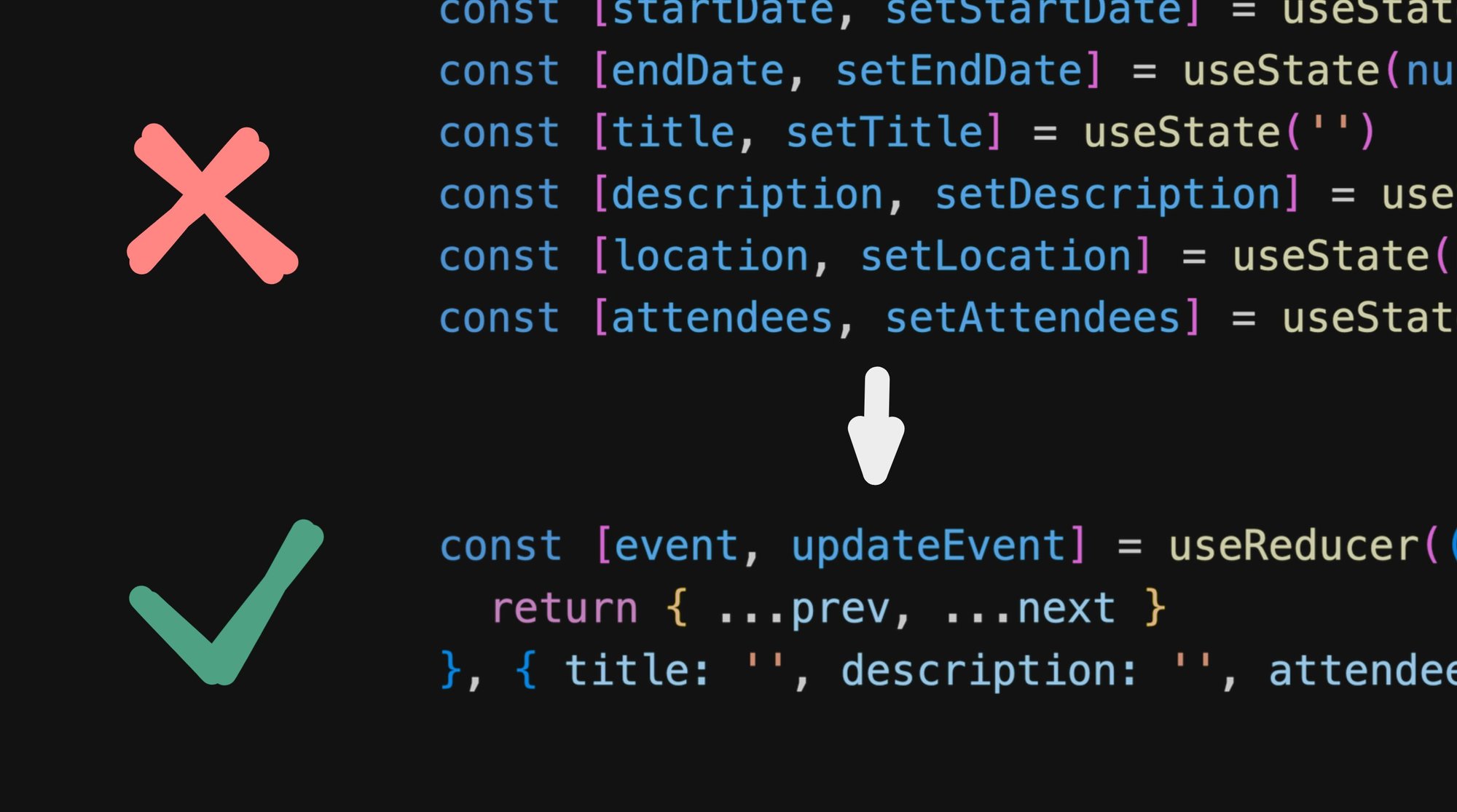Do you ever find yourself in React useState hook hell?
Yeah, this good stuff:
import { useState } from 'react'
function EditCalendarEvent() {
const [startDate, setStartDate] = useState()
const [endDate, setEndDate] = useState()
const [title, setTitle] = useState('')
const [description, setDescription] = useState('')
const [location, setLocation] = useState()
const [attendees, setAttendees] = useState([])
return <>
<input value={title} onChange={e => setTitle(e.target.value)} />
{/* ... */}
</>
}The above is a component to update a calendar event. Sadly, it has a number of problems.
Besides not being easy on the eyes, there are no safeguards here. There’s nothing preventing you from choosing an end date that’s before the start date, which makes no sense.
There’s also no guard for a title or description that is too long.
Sure, we could hold our breath and trust that everywhere we’re calling set*() we will remember (or even know) to validate all of these things before writing to state, but I don’t rest easy knowing things are just sitting in such an easy to break state.
Did you know that there is an alternative state hook that is more powerful and easier to use than you might think?
Using useReducer, we could transform the above code, to just this:
import { useReducer } from 'react'
function EditCalendarEvent() {
const [event, updateEvent] = useReducer((prev, next) => {
return { ...prev, ...next }
}, { title: '', description: '', attendees: [] })
return <>
<input value={event.title}
onChange={e => updateEvent({ title: e.target.value }) } />
{/* ... */}
</>
}The useReducer hook helps you control transformations from state A to state B.
Now, you could say “I can do that with useState too, see” and point to some code like this:
import { useState } from 'react'
function EditCalendarEvent() {
const [event, setEvent] = useState({
title: '', description: '', attendees: []
})
return <>
<input value={event.title}
onChange={e => setEvent({...event, title: e.target.value }) } />
{/* ... */}
</>
}Though you’d be right, there’s one very important thing to consider here. Besides that this format still hopes that you always remember to spread on ...event so you don’t mess up by mutating the object directly (and subsequently causing React to not rerender as expected), it still misses out on the most critical benefit of useReducer — the ability to supply a function that controls state transitions.
Going back to using useReducer, the only difference is you get an additional argument that is a function that can help us ensure that each state transition is safe and valid:
const [event, updateEvent] = useReducer(
(prev, next) => {
// Validate and transform event, to ensure state is always valid
// in a centralized way
// ...
},
{ title: "", description: "", attendees: [] }
);This has the major benefit of guaranteeing that your state is always valid, in a fully centralized way.
So with this model, even if future code is added over time, and future developers on your team call updateEvent() with potentially invalid data, your callback will always fire.
For instance, we may want to always ensure, no matter how and where state is written, that the end date is never before the start date (as that would make no sense), and that the title has a max length of 100 characters:
import { useReducer } from "react";
function EditCalendarEvent() {
const [event, updateEvent] = useReducer(
(prev, next) => {
const newEvent = { ...prev, ...next };
// Ensure that the start date is never after the end date
if (newEvent.startDate > newEvent.endDate) {
newEvent.endDate = newEvent.startDate;
}
// Ensure that the title is never more than 100 chars
if (newEvent.title.length > 100) {
newEvent.title = newEvent.title.substring(0, 100);
}
return newEvent;
},
{ title: "", description: "", attendees: [] }
);
return (
<>
<input
value={event.title}
onChange={(e) => updateEvent({ title: e.target.value })}
/>
{/* ... */}
</>
);
}This ability to prevent direct mutation of state gives us a major safety net, especially as our code grows in complexity over time.
Note that you should also provide validation in your UI as well. But think of this as an additional set of safety guarantees, a bit like an ORM over a database, so that we can be fully assured that our state is always valid when written. This can help us prevent strange and hard to debug issues in the future.
Maybe you have the world's simplest component, a basic counter, so you are using the useState hook:
import { useState } from 'react'
function Counter() {
const [count, setCount] = useState(0);
return (
<button onClick={() => setCount(count + 1)}>
Count is {count}
</button>
);
}But even in this small example, should count be able to go infinitely high? Should it ever be negative?
Ok, maybe it’s not so conceivable how a negative value could be achieved here, but if we wanted to set a count limit, it’s trivial with useReducer and we can have complete confidence that the state is always valid, regardless of where and how it’s written to.
import { useReducer } from 'react'
function Counter() {
const [count, setCount] = useReducer((prev, next) => Math.min(next, 10), 0);
return (
<button onClick={() => setCount(count + 1)}>
Count is {count}
</button>
);
}As things get more complex, you could even opt to use a redux style action-based pattern as well.
Going back to our calendar event example, we could alternatively write it similar to the below:
import { useReducer } from 'react'
function EditCalendarEvent() {
const [event, updateEvent] = useReducer((state, action) => {
const newEvent = {...state}
switch (action.type) {
case 'updateTitle':
newEvent.title = action.title;
break;
// More actions...
}
return newEvent
}, { title: '', description: '', attendees: [] })
return <>
<input value={event.title}
onChange={e => updateEvent({ type: 'updateTitle', title: 'Hello' }) } />
{/* ... */}
</>
}If you look up just about any docs or articles about useReducer, they seem to imply this is the one and only way to use the hook.
But I want to impress upon you that this is just only one of many patterns you can use this hook for. While this is subjective, I am personally not a huge fan of Redux and this exact pattern.
It has its merits, but I think once you want to start layering in new abstractions for actions, Mobx, Zustand, or XState are preferable in my personal opinion.
That said, there is something elegant about being able to utilize this pattern without any additional dependencies, so I’ll give people who love this format that.
One other nicety of useReducer is it can be handy when child components need to update data managed by this hook. As opposed to having to pass several functions like you would when using useState, you could just pass your reducer function down.
From an example in the React docs:
const TodosDispatch = React.createContext(null);
function TodosApp() {
// Note: `dispatch` won't change between re-renders
const [todos, updateTodos] = useReducer(todosReducer);
return (
<TodosDispatch.Provider value={updateTodos}>
<DeepTree todos={todos} />
</TodosDispatch.Provider>
);
}Then from the child:
function DeepChild(props) {
// If we want to perform an action, we can get dispatch from context.
const updateTodos = useContext(TodosDispatch);
function handleClick() {
updateTodos({ type: 'add', text: 'hello' });
}
return (
<button onClick={handleClick}>Add todo</button>
);
}This way you can not only have just one unified update function, but have safety guarantees that state updates triggered by child components conform to your requirements.
It is important to keep in mind that you must always treat the state value of the useReducer hook as immutable. A number of problems can occur if you accidentally mutate the object in your reducer function.
For instance, an example from the React docs:
function reducer(state, action) {
switch (action.type) {
case 'incremented_age': {
// 🚩 Wrong: mutating existing object
state.age++;
return state;
}
case 'changed_name': {
// 🚩 Wrong: mutating existing object
state.name = action.nextName;
return state;
}
// ...
}
}and the fix:
function reducer(state, action) {
switch (action.type) {
case 'incremented_age': {
// ✅ Correct: creating a new object
return {
...state,
age: state.age + 1
};
}
case 'changed_name': {
// ✅ Correct: creating a new object
return {
...state,
name: action.nextName
};
}
// ...
}
}If you find you are often running into this problem, you could enlist the help of a small library:
One very nifty library for ensuring immutable data, while having an elegant mutable DX, is Immer.
The use-immer package additionally provides a useImmerReducer function that allows you to make state transitions via direct mutation, but under the hood creates an immutable copy using Proxies in JavaScript.
import { useImmerReducer } from "use-immer";
function reducer(draft, action) {
switch (action.type) {
case "increment":
draft.count++;
break;
case "decrement":
draft.count--;
break;
}
}
function Counter() {
const [state, dispatch] = useImmerReducer(reducer, initialState);
return (
<>
Count: {state.count}
<button onClick={() => dispatch({ type: "increment" })}>+</button>
<button onClick={() => dispatch({ type: "decrement" })}>-</button>
</>
);
}This of course is completely optional, and only needed if this solves problems you are actively encoutering.
Despite my enthusiasm for useReducer, and pointing out the many places you could use it, let’s remember not to prematurely abstract.
In general, you are likely still fine using useState. I would consider incrementally adopting useReducer as your state and validation requirements begin to get more complex, warranting the additional effort.
Then, if you are adopting useReducer for complex objects frequently, and often hit pitfalls around mutation, introducing Immer could be worthwhile.
That, or if you’ve gotten to this point of state management complexity, you may want to look at some even more scalable solutions, such as Mobx, Zustand, or XState to meet your needs.
But don’t forget, start simple, and add complexity only as needed.
This post was inspired by David Khourshid, creator of XState and Stately, who opened my eyes to the possibilities of the useReducer hook with his epic twitter thread:
Hi! I'm Steve, CEO of Builder.io.
If you like our content, you can subscribe to us on dev.to, twitter, or our newsletter.
We make a way to drag + drop with your components to create pages and other CMS content on your site or app, visually.
You may find it interesting or useful:
Introducing Visual Copilot: convert Figma designs to high quality code in a single click.























